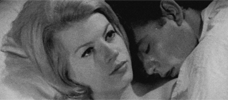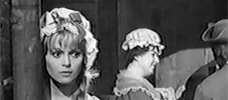Reviews
Reviews Bosomania!: The Sex, the Violence, and the Vocabulary of Russ Meyer

The Immoral Mr. Teas / Eve and the Handyman
Russ Meyer
USA, 1959 / 1961
Credits
Review by Leo Goldsmith
Posted on 25 August 2008
Source RM Films International VHS
Categories Bosomania!: The Sex, the Violence, and the Vocabulary of Russ Meyer
The Immoral Mr. Teas and Eve and the Handyman dovetail as examples of Russ Meyers early style of exploitation cinema: both were shot cheaply and quickly (the former for $24,000 over four days) with voiceover instead of live or synchronized sound; both are constructed as a sequence of loosely connected comic episodes; both exercise a tireless taste for double entendres; and both illustrate the persistent sexual preoccupations of “modern man,” embodied in both films by proletarian protagonists.
Through these protagonists the films announce their politics. “Modern man” is, by 1959, synonymous with the “common man”—the Handyman or the deliveryman, the lower middle-class worker, who wants nothing so much as to blow off some steam on his off-hours. And in Meyer’s films, this steam is generally blown off through sex—thinking about it, if not by actually having it. The point here is two-fold:
- that the subject of sex is no longer the exclusive province of the stag film or the gentleman’s club, but is available to the public at large, a source of entertainment suitable for communal spectatorship in a movie theater or strip club (the latter of which is a setting in both films);
and
- that insofar as sex, so utterly pervasive in the “modern” life of 1959, is a subject of public discourse, so too are the social and psychological problems it causes, and therefore both films seek (somewhat disingenuously) to analyze and address these problems in the form of the educational or industrial film (i.e. with the help of instructive voiceovers, bland music, the consultation of specialists, and so on).
What’s interesting is that, while both take up the common theme of the sexual temptations and preoccupations of this “modern man,” each story has its own moral - or immoral, if you prefer - that is wholly distinct from that of the other film, at least on the surface.
The films are essentially identical in structure: a series of comic sexual situations inadvertently presenting themselves to the title male protagonists, with shocked reactions. But whereas the Handyman of the latter film, as we shall see, is a model of moral rectitude, a dutiful, pencil-necked, uptight prude, Mr. Teas is stocky, hirsute, unwedded to his work as a deliveryman, and has an occasionally visible tattoo. In other words, in spite of the boater he occasionally sports, he is an emphatically working-class “modern man,” and in Meyer’s film, he is continually beset by the sexual fixations of the age, from both within and without.
Beginning with one of Meyer’s typically manic montages, the film posits a familiar contrast between city and country: Los Angeles, the bustling, chaotic metropolis, and the rustic California countryside around it, promising clean air and the restorative sights and activities of nature. The city is home to Mr. Teas’ workaday frustrations - commutation, his dull job, a toothache, unfulfilling encounters with bosomy receptionists, nurses, coffee-shop waitresses - while the country is where he takes his leisure - fishing, beachcombing, and eventually letting his imagination run free.
It is at this point that The Immoral Mr. Teas’ rudimentary narrative becomes most inventive and therefore most interesting, as the offscreen narrator asks, “Has the pressure of modern living begun its insidious task of breaking down the moral fiber of our indomitable Mr. Teas?” Plagued by daytime fantasies about the inordinate number of large-breasted women he sees on a daily basis, and similarly vexed by a throbbing “toothache,” Mr. Teas visits the dentist for treatment. The dentist’s Novocain causes a series of profound changes in the protagonist’s sensorium. When drugged or asleep, he’s visited by still more psycho-psychedelic visions - first of fruit (bananas, coconuts, the pink center of a watermelon), and later of a large tooth being extracted (which is in fact a white, bloody antler) - and in his waking life, he is magically able to see through women’s clothing.
Enter Dr. Freud—or in Meyer’s film, Dr. C. P. Floodback, a bespectacled vixen with large breasts (you see where this is going). The voiceover explains:
Psychiatry: a friendly oasis in the vast descent of masculine frustrations. The minute examination of the mind to discover the underlying mental causes of certain mental and nervous disorders.
Freud’s theories of sexuality and the unconscious, fully popularized by 1959, had infiltrated the vernacular, and therefore the cinema, of postwar America. Hitchcock’s contemporary films, like Psycho and Marnie, are only the most discussed examples of this prevalence, but their place in mainstream culture suggests something of the popular milieu in which Meyer was working. If Meyer’s touch is a little broader than Hitchcock’s in this regard (as instanced by naughtily-shaped fruit and the removal of teeth, which symbolizes the guilt associated with masturbation in Freud’s dream analysis), it nonetheless conveys the impression that “modern man” is inherently, universally a sexual animal.
To this end, much of the latter portion of the film comprises a series of idyllic episodes of plus-sized women in the rustic, natural settings where Mr. Teas spends his recreational hours, blowing off steam from by watching women frolic in water, row around in boats, pluck guitars—all without the hindrance of clothing. (As accompaniment, and to bolster the ironic notion that this is some kind of educational film, the voiceover rattles off a string of double-entendres thinly disguised as useful facts about rubber, water, and the like.) These scenes show “modern man” at play and suggest not only that sex is always on his mind, but also that sexual fantasy is his primary respite from the drudgeries of labor. The universality of this point about male psychology is driven home, as it were, in the final scenes, in which Mr. Teas lies on Dr. Floodback’s couch only to see his bosomy psychiatrist become magically bare-breasted before his eyes. “On the other hand,” we are told, “some men just enjoy being sick.”
Whereas The Immoral Mr. Teas is a film about sex as leisure, Eve and the Handyman might be characterized as a film about sex-work. As such, it is a good deal more conservative in how it analyzes the psychosexual preoccupations of both men and women, and in how it relates these concerns to their workaday lives. The latter film begins in the form of a film noir (albeit, a sunny one), its opening sequence comprising a series of canted-angle shots of Eve Meyer (Russ’ buxom wife), dressed in a fedora and trenchcoat. These shots are accompanied by a hard-boiled voiceover narration, delivered by Eve, detailing in oblique, yet suggestive terms what she’s doing: “I’m a big girl in a big town with a big job.” Just what this job is we don’t know, but it entails following “the Handyman,” a nebbish character in overalls, as he undergoes a succession of increasingly risqué situations, usually starring Eve Meyer - somewhat confusingly - as other large-breasted characters, as Eve herself (in fedora, etc.) observes and narrates from the sidelines. These situations - which range from childish to puerile to puzzling - amount to almost nothing but what Eve describes as a process of learning to “out-smart” the Handyman to beat him in some kind of game or competition to which we have not yet been made privy. “I was the one gal who might be able to handle him,” she croons smokily, “in a desperate race against time.”
In spite of the urgency of this statement, however, there is little in the situational comedy (such as it is) that suggests time-sensitivity. Though Eve lustily proclaims, “the rougher the customer, the better I like it,” the Handyman is comically presented as a pipsqueak and a prude. Eve speaks of his prowess and skill on the soundtrack, even as we see him scrubbing toilets, washing windows, and performing other dull, menial tasks. All the while, sexual “hazards” present themselves - cleavages and bare breasts are unveiled, bosoms enlarge and subtract before our eyes, women hitchhike naked - and the Handyman chastely avoids them either inadvertently or by virtue of his cautious aversion to temptations of the flesh.
It is only in the final scene that Eve’s “job” is revealed. Cornering the Handyman in his bedroom, Eve joyously proclaims her victory in voiceover before unfastening her trenchcoat and flashing the unsuspecting roustabout. After a brief shot from behind Eve, which suggests the Handyman likes what he sees and is unable to contain this pleasure, it is revealed that Eve is not flashing her breasts, but rather a neon sign - literally flashing an advertisement - for “Strump” toilet brushes. The two then fall into bed with one another, and thence into some form of domestic, even marital bliss.
Baffling and crude (in both senses) though this film is, even in the supposedly expository punchline, it also bears a faint odor of conservatism. This is a subtle vein that runs through Meyer’s career, subsumed under the sex, drugs, and rock ‘n’ roll of a film like Beyond the Valley of the Dolls, only to manifest in the “punishment” of the lesbian characters in that film’s denouement. This conservatism is rarely as overt in Meyer’s work as it is in Eve and the Handyman, which seems to imply that Eve’s “job” is to find a man, seemingly impervious to temptations, whom she will make her own. Not only does this imply marriage rather than promiscuity, it also suggests the interconnectedness of marriage (and sex) and work, as denoted by the toilet brushes - coyly named “Strump” - by which the Handyman is so turned on. Marriage, sex, and work are thus all so deeply connected to the experience of “modern man” - that is, hetero-normative 1950’s bourgeois living - that they can serve as metonyms for one another: sex as work (as suggested by all of Eve’s double-entendres about her own job), and the “job” of marriage (as suggested by the toilet brushes and neon advertisement attached to Mrs. Meyer’s body).
In effect, while each film posits a distinct role for sexuality in the life of this “modern man,” both films determine that this role is a prominent one. Though each seems to make a different point about the relation of sex to fidelity, both films suggest the social function of sex - as a form of work or of recreation, each contributing in some form to the overall health of the social order. At the dawn of the 1960s, this more liberal notion of sexuality could only be considered “sick” by outmoded standards, under conditions in which the subject of sex is confined to men’s locker rooms or psychiatrist’s journals, and the image of sex is barred from movie screens. This is why Meyer’s early films facetiously effect the form of educational films: they are public announcements serving a social function and the common good.
More Bosomania!: The Sex, the Violence, and the Vocabulary of Russ Meyer
-

The Immoral Mr. Teas / Eve and the Handyman
1959 / 1961 -

Lorna
1964 -

Fanny Hill
1964 -

Mudhoney
1965 -

Faster, Pussycat! Kill! Kill!
1965 -

Motor Psycho
1965 -

Mondo Topless
1966 -

Common-Law Cabin
1967 -

Good Morning and… Goodbye!
1967 -

Finders Keepers, Lovers Weepers!
1968 -

Vixen!
1968 -

Cherry, Harry & Raquel!
1970 -

Beyond the Valley of the Dolls
1970 -

The Seven Minutes
1971 -

Black Snake
1973 -

Supervixens!
1975 -

Up!
1976 -

Beneath the Valley of the Ultravixens
1979
We don’t do comments anymore, but you may contact us here or find us on Twitter or Facebook.


